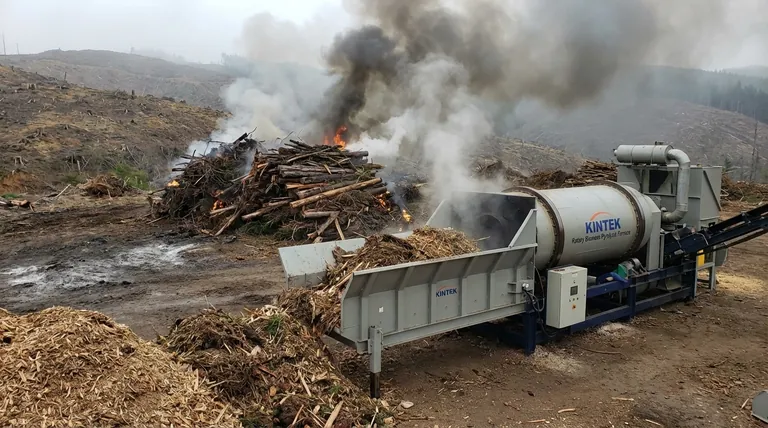재생 가능한 자원이라는 명성에도 불구하고, 바이오매스 에너지는 상당한 환경적 단점을 가지고 있습니다. 주요 단점으로는 높은 탄소 배출 가능성, 산림 벌채 및 서식지 파괴 위험, 그리고 상당한 토지 및 수자원 소비가 있습니다. 바이오매스가 "탄소 중립"이라는 일반적인 가정은 실제 환경 비용을 가리는 위험한 과도한 단순화입니다.
바이오매스의 핵심 문제는 환경적 이점이 전적으로 조건적이라는 것입니다. 소규모 응용 분야에서 폐기물의 지속 가능한 사용이 될 수 있지만, 대규모 에너지 생산에 사용될 경우 탄소 부채에서 생태계 손상에 이르기까지 화석 연료에 필적하는 환경 문제를 야기하는 경우가 많습니다.

탄소 중립 신화
바이오매스의 핵심 주장은 자연 탄소 순환의 일부라는 것입니다. 나무가 탄소를 흡수하고, 에너지로 태워지고, 새로운 나무가 다시 자라 같은 탄소를 재흡수합니다. 현실에서 이 순환은 쉽게 깨집니다.
"탄소 부채" 문제
나무가 태워지면 저장된 탄소가 거의 즉시 대기 중으로 방출됩니다. 그러나 새로운 나무가 자라 동등한 양의 탄소를 재흡수하는 데는 수십 년, 심지어 수세기가 걸립니다.
이러한 시간 지연은 "탄소 부채"를 만듭니다. 상당 기간 동안 대기 중에는 더 많은 CO2가 존재하며, 이는 화석 연료와 마찬가지로 기후 변화에 기여합니다.
굴뚝에서의 배출
메가와트시당 기준으로, 나무를 태우는 것은 실제로 석탄을 태우는 것보다 더 많은 CO2를 굴뚝에서 배출할 수 있습니다.
CO2 외에도 바이오매스 연소는 질소산화물(NOx), 휘발성 유기 화합물(VOCs), 미세먼지(PM2.5)를 포함한 다른 유해 대기 오염 물질도 배출하며, 이는 스모그, 산성비 및 공중 보건 문제에 기여합니다.
토지 및 생태계에 미치는 영향
바이오매스 연료의 원천은 환경 영향에 가장 중요한 단일 요소입니다. 연료를 위해 숲에 의존하는 것은 자연 생태계에 엄청난 압력을 가합니다.
산림 벌채 위험
목재 펠릿 및 기타 바이오매스 연료에 대한 수요 증가는 산림 잔여물이나 폐목재 사용을 넘어선 자연림, 특히 오래된 숲의 벌목을 장려할 수 있습니다.
이러한 관행은 중요한 탄소 흡수원을 파괴하여 숲이 CO2를 대기에서 영원히 흡수하는 능력을 없앱니다.
생물 다양성 손실
다양한 자연림을 바이오매스 시설에 공급하기 위한 단일 수종 조림지로 전환하는 것은 복잡한 서식지를 파괴합니다. 이 관행은 자연림 생태계에 의존하는 수많은 식물, 동물 및 곤충 종에 영향을 미쳐 지역 생물 다양성을 황폐화시킵니다.
토양 황폐화
그루터기, 가지, 낙엽과 같은 "산림 잔여물"을 바이오매스로 사용하는 것은 숲 바닥에서 필수 유기물을 빼앗습니다. 이 물질은 일반적으로 분해되어 토양에 중요한 영양분을 되돌려줍니다. 이 물질의 제거는 장기적인 토양 황폐화를 초래하고 숲의 전반적인 건강과 회복력을 감소시킵니다.
절충점과 숨겨진 비용 이해하기
직접적인 배출과 산림 영향 외에도 전체 바이오매스 공급망에는 종종 간과되는 숨겨진 환경 비용이 있습니다.
높은 물 소비량
바이오매스를 위한 전용 에너지 작물이나 관리된 숲을 재배하는 것은 엄청나게 물을 많이 소비하는 과정입니다. 물 부족 지역에서는 이는 지역 상수도에 심각한 부담을 주어 지역 사회와 자연 수생 생태계 모두에 영향을 미칠 수 있습니다.
토지 이용 경쟁
에너지 작물을 재배하기 위해 광대한 토지를 사용하는 것은 식량 생산에 필요한 토지와 직접적으로 경쟁할 수 있습니다. 이러한 경쟁은 식량 가격 상승과 식량 불안정에 기여하여 에너지 수요와 인간의 필요 사이의 갈등을 야기할 수 있습니다.
물류 및 에너지 투입
바이오매스 공급망은 에너지가 필요 없는 것이 아닙니다. 원자재를 수확, 가공, 운송 및 저장하는 데 상당한 에너지가 필요합니다.
또한, 제공된 참고 자료에서 언급했듯이, 바이오매스를 저장하려면 부패를 방지하기 위해 비용이 많이 들고 유지 보수가 필요한 시설이 필요합니다. 이러한 물류적 장애물은 전반적인 비용과 환경 발자국을 증가시켜 순 에너지 이득을 감소시킵니다.
목표에 맞는 올바른 선택하기
바이오매스가 "친환경" 에너지원으로서의 타당성은 단순한 예 또는 아니오가 아닙니다. 이는 전적으로 프로젝트의 규모와 연료의 원천에 따라 달라집니다.
- 진정한 폐기물에서 나오는 소규모 에너지에 중점을 둔다면: 농업 잔여물, 도시 유기 폐기물 또는 버려질 제재소 부산물을 사용할 때 바이오매스는 지속 가능한 선택이 될 수 있습니다.
- 대규모 산업 발전이 주요 초점이라면: 산림 벌채, 탄소 부채 및 생태계 손상을 포함한 환경적 위험이 상당하며, 종종 바이오매스를 태양광 또는 풍력과 같은 진정으로 저탄소 에너지원의 열악한 대체재로 만듭니다.
- 에너지 정책 평가가 주요 초점이라면: "탄소 중립"이라는 포괄적인 주장을 거부하고 토지 이용 변화 및 탄소 부채 기간을 포함한 바이오매스 원천의 전체 수명 주기를 면밀히 조사하는 것이 중요합니다.
궁극적으로 바이오매스를 판단하려면 단순한 "재생 가능"이라는 라벨을 넘어 기후와 생태계에 미치는 실제 영향을 엄격하게 평가해야 합니다.
요약표:
| 주요 단점 | 환경 영향 |
|---|---|
| 탄소 부채 | CO2 재흡수의 시간 지연이 기후 변화를 악화시킵니다. |
| 산림 벌채 위험 | 탄소 흡수원 및 생물 다양성 손실. |
| 대기 오염 | 단위당 석탄보다 더 많은 CO2, NOx, PM2.5를 배출합니다. |
| 토양 황폐화 | 산림 잔여물 제거가 토양 영양분을 고갈시킵니다. |
| 높은 물 사용량 | 물 부족 지역에서 지역 수자원에 부담을 줍니다. |
| 토지 경쟁 | 식량 생산과 충돌하여 식량 가격을 상승시킵니다. |
에너지 또는 실험실 프로젝트를 위한 정확하고 지속 가능한 솔루션이 필요하십니까? KINTEK은 정확한 환경 영향 분석 및 지속 가능한 연구를 지원하는 첨단 실험실 장비 및 소모품을 전문으로 제공합니다. 에너지원을 평가하거나 친환경 기술을 개발하든, 당사의 도구는 신뢰할 수 있는 데이터와 효율성을 보장합니다. 오늘 저희에게 연락하여 KINTEK이 최첨단 실험실 솔루션으로 귀하의 작업을 어떻게 지원할 수 있는지 알아보십시오!
시각적 가이드

관련 제품
- 전기 회전 가마 소형 회전 로 바이오매스 열분해 장치
- 유기물 증발 접시
- 초강력 음이온 산소 발생기 공기 정화기
- 전기 회전 가마 연속 작업 소형 회전 용광로 가열 열분해 플랜트
- 탄소 재료용 흑연 진공로 하부 배출 그래프화로






